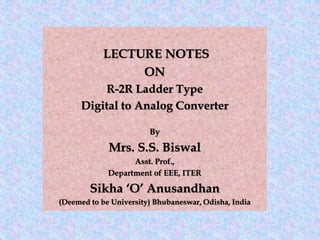
R2 r dac
- 1. LECTURE NOTES ON R-2R Ladder Type Digital to Analog Converter By Mrs. S.S. Biswal Asst. Prof., Department of EEE, ITER Sikha ‘O’ Anusandhan (Deemed to be University) Bhubaneswar, Odisha, India
- 2. The most important digital tools for process control systems is one that translates digital information to analog and vice versa [1]. 1
- 3. The increasing use of digital computers in measurement and control systems and the scarcity of true digital measuring devices lead to a need for converters to allow analogue sensors to communicate with computers or the digital output of the computers to communicate with analogue systems[2]. 2
- 4. Basically converters are of two types [3,4]. Digital-to-analog (DAC or D/A or D-to-A) Analog-to-digital (ADC or A/D or A-to-D) A/D and D/ A converters relate analog quantities to digital quantities and vice versa through an appropriate code [5]. 3
- 5. A digital to analog converter has an input of digital signals and an output of an analog signal[6]. A DAC is used to convert a digital signal to the analog format. 4
- 6. A DAC has an input of digital signals and an output of an analogue signal[5]. An 8-bit DAC may produce an output signal of 2.56V when the digital inputs see a word of 111111112. 5
- 7. Resolution: The number of possible output levels the DAC is designed to reproduce. This is usually stated as the number of bits it uses, which is the binary logarithm of the number of levels. Maximum sampling rate: The maximum speed at which the DACs circuitry can operate and still produce correct output. Dynamic range: A measurement of the difference between the largest and smallest signals the DAC can reproduce expressed in decibels. This is usually related to resolution and noise floor. 6
- 8. Monotonicity: This refers to the ability of a DAC's analog output to move only in the direction that the digital input moves (i.e., if the input increases, the output doesn't dip before asserting the correct output). THD+N: This is a measurement of the distortion and noise introduced to the signal by the DAC. It is expressed as a percentage of the total power of unwanted harmonic distortion and noise that accompany the desired signal. 7
- 9. Pulse-width modulator (PWM)DAC Oversampling or interpolating DAC Binary-weighted DAC R-2R ladder DAC Thermometer-coded DAC Hybrid DAC The segmented DAC 8
- 10. The most common DAC structure is the R- 2R resistor ladder network. It uses resistors of only two different values, and their ratio is 2:1. An N-bit DAC requires 2N resistors, and they are quite easily trimmed. 9
- 11. As the name suggests, R-2R Ladder DAC produces an analog output, which is almost equal to the digital (binary) input by using a R-2R ladder network in the inverting adder circuit. A 4-bit DAC 10
- 12. Vref V2V1 V3 ref ref ref ref out 3 2 1 0 2 4 8 16 V V V V V R b b b b R R R R 11 A 4 bit R-2R ladder network with output equation
- 13. A practical circuit implementation of a R-2R ladder DAC 12
- 14. Advantages: It contains only two values of resistor: R and 2R. So, it is easy to select and design more accurate resistors. Does not require high precision resistors Number of bits can be expanded by adding more sections of same R/2R values. In inverted R/2R ladder DAC, node voltages remain constant with changing input binary words. Disadvantages: The conversion rate is lower as compared to binary weighted digital to analog converter.13
- 15. Problem 1 What is the largest value of output voltage from an 8- bit DAC that produces 1.0V for a digital input of 00110010? Solution 1: 001100102 = 5010 1.0 V = K× 50 Therefore, K = 20 mV The largest output will occur for an input of 111111112 = 25510 VOUT(max) = 20mV×255 = 5.10 V 14
- 16. Problem 2 A 5-bit D/A converter produces VOUT = 0.2 V for a digital input of 0001. Find the value of Vout for an input of 11111. Solution 2: Obviously, 0.2 V is the weight of the LSB. Thus, the weights of the other bits must be 0.4 V, 0.8 V, 1.6 V, and 3.2 V respectively. For a digital input of 11111, then, the value of VOUT will be 3.2 V + 1.6 V+ 0.8V + 0.4V + 0.2 V = 6.2 V. 15
- 17. Computer driven CRT displays Computer Printers Digital Motor Control Digital Thermostat Digital control of automatic process control systems Electronic Cruise Control Sound Equipment (e.g. CD/MP3 Players, etc.) 16
- 18. 1. C. D. Johnson, Process control instrumentation technology, Prentice Hall PTR ,1999. 2. Ernest O. Doebelin, Measurement Systems- Application and Design, TMH, 2007. 3. Joseph J.Carr, Elements of Electronics Instrumentation and Measurement, Pearson Education, 2003. 4. Alan. S. Morris, Principles of Measurements and Instrumentation, 2nd Edition, Prentice Hall of India, 2003. 17
- 19. 5. Sawhney, A. K., and P. Sawhney. "Electrical and electronics measurements and measuring instruments." Measurement and Measurement Systems (2003). 6. Bolton, William. Industrial control and instrumentation. Universities Press, 1993. 7. Albert D.Helfrick and William D.Cooper – Modern Electronic Instrumentation and Measurement Techniques, Pearson / Prentice Hall of India, 2007. 18
- 20. 1.What is a DAC? 2. What function does a DAC perform? 3.What are the different types of DAC circuits? 3. What is the resolution of a DAC? 4.What is the advantage of R/2R ladder DAC over the DAC that uses binary weighted resistors? 5. An 8-bit DAC has an output of 3.92 mA for an input of 01100010. 6.What are the DAC’s resolution and full-scale output? 7.What is the percentage resolution of an 8-bit DAC? 8.How many different output voltages can a 12-bit DAC produce? 19
- 21. 20